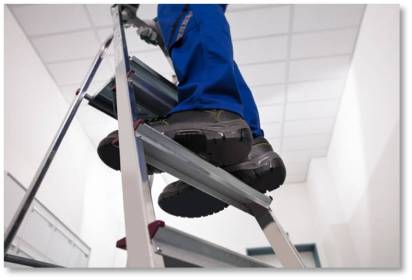Falls from ladders are preventable: Make ladder safety a priority

Each year in the U.S., more than 100 people die and thousands more are injured from ladder-related falls. March is ladder safety month. Learn more about how to prevent extension ladder and step ladder-related fall injuries and deaths.
Ladder fall injuries are a persistent hazard both in the workplace and at home. There are five major causes for ladder fall incidents:
- Incorrect extension ladder setup angle — In approximately 40% of cases, the leading cause of ladder-related injuries is a ladder sliding out at the base due to an incorrect setup angle.
- Inappropriate ladder selection — Selection of a ladder with the proper duty-rating is also important to avoid structural failure. Selection of a ladder made of nonconductive material can avoid electrocution and related falls.
- Insufficient ladder inspection — Reduce the likelihood of ladder structural failure by practicing regular inspection and maintenance.
- Improper ladder use — Activities such as overreaching, carrying objects, applying excessive force, slips, and missteps are also frequent causes of ladder-related fall injuries.
- Lack of access to ladder safety tools and information — Small companies that account for up to 80% of all construction companies, and individual ladder users, such as homeowners, do not typically receive the required training for safe use of extension ladders and step ladders.
Tips to stay safe when using a ladder
- Select the right type of ladder to match the job:
- Ensure the ladder is the right height. If it is too short, it can lead to overreaching and ladder instability.
- Consider the ladder material. The material should be nonconductive when working near live wires to avoid the risk of electrocution that could kill you. Stay at least ten feet away from power lines.
- Pay attention to the duty rating. Duty rating is the maximum amount of weight the ladder is manufactured to safely carry. It means that the ladder is strong enough to handle your weight plus your equipment. If the ladder has an insufficient duty rating, it can structurally fail.
- Inspect the ladder for damage. Look for missing rungs, bolts, cleats, screws, loose components, or other defects. If you find defects, immediately mark the ladder as defective or tag it with “Do Not Use” or similar language.
- Position the ladder in a safe location. The ladder should be on a level, supportive surface without contaminants. Place the ladder in a low traffic area or put barriers around it to prevent a person or equipment from bumping into the ladder.
- Maintain three points of contact. Avoid carrying materials and equipment, which could lead to loss of stability or balance. Never step above the second highest step on a step ladder or the fourth highest rung on an extension ladder.
The angle of the ladder should be about 75 degrees. Additionally, ensure the extension ladder extends at least three feet above the roof or structure edge to reduce the risk of tipping or sliding sideways. Ensure your ladder is at the proper angle by using NIOSH’s Ladder Safety app.
NIOSH Ladder Safety Mobile App

To prevent extension and step ladder-related fall injuries and deaths, download and use NIOSH’s award-winning Ladder Safety app.
The NIOSH Ladder Safety App has an angle of inclination indicator which uses visual and audible signals making it easier for workers and other users to set an extension ladder at the proper angle of 75.5 degrees. The app can help workers prevent falls and is also a tool for employers who want to ensure a safe workplace.
Get the app: Download the app for free at Apple Store and Google Play. The app is available in English and Spanish.
NIOSH: Falls in the Workplace: Ladder Safety Mobile App
NIOSH: Video – The Updated NIOSH Ladder Safety Mobile App
OSHA: Ladder Safety Publications
American Ladder Institute: Basic Ladder Safety
